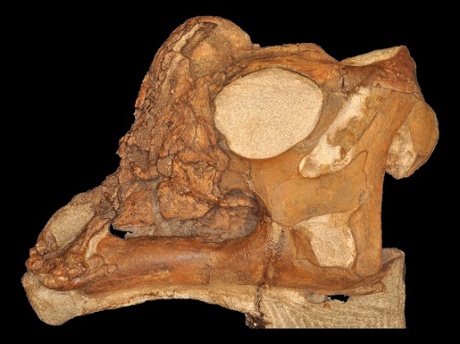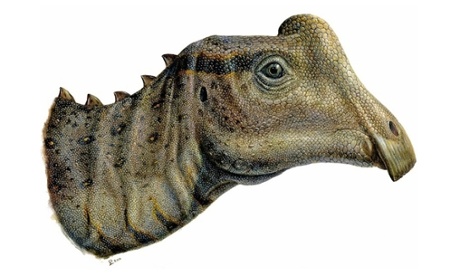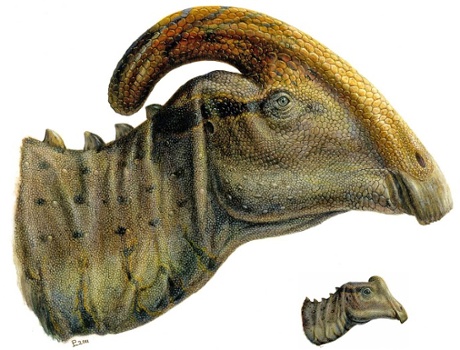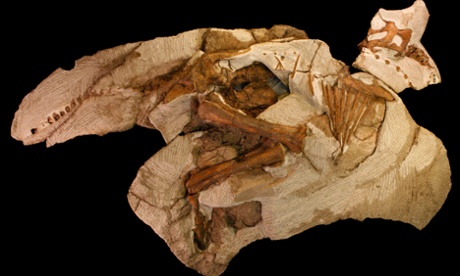
Product Categories
Our newsletter
Beautiful baby dinosaur delights palaeontologists

Life reconstruction of the new baby dinosaur by Lukas Panzarin. Photograph: /Andy Farke Despite the fact that they were likely very numerous indeed, baby dinosaurs are actually extremely rare to find as a fossil and so any new discovery is to be welcomed. There are some inherent biases in the fossil record such that some things tend to preserve more often than you would expect by chance and others are much more rare. One of the major biases is against young vertebrate animals since being small they are harder to find, and as they are still growing their bones contain more cartilage and so are less likely to preserve well.
The new baby dinosaur described today belongs to the genus Parasaurolophus a member of the group called the hadrosaurs (often known as duck-billed dinosaurs) and is in beautiful condition and in particular has a very well preserved skull. The kinds of details that such specimens can bring to questions of growth and development are most important for understanding dinosaur ecology and this baby, which clocks in at less than 6 feet (around 1.8 m) in total length, has a lot to tell us.

The beautifully preserved skull of the new baby Parasaurolophus. Photograph: Andy Farke In the Late Cretaceous of North America, hadrosaurs were at their peak. Huge numbers of these animals from many different species roamed the continent, browsing on the local plant life and grinding it up with wonderfully specialised jaws that allowed them to deal with even tough plants effectively. The front of their snouts housed a beak (which in part gives them their nickname) which is actually partly preserved in the baby. However, the most obvious feature of most hadrosaurs was the wide variety of crests that extended from the tops of their heads. These features were probably, at least in part, signals to mates or rivals about the status of the animal in question, but in several they would have been more than just a visual signal.
In Parasaurolophus, this crest is a huge and slightly curved "horn" that rises from the skull and arches over its back. Inside, this crest is both hollow and is a loop that links to the nasal passages in the skull – it is in fact nothing so much like a giant dinosaurian trombone or didgeridoo. It is thought this was used by the animals to communicate, and it certainly would have helped change and channel their calls. However, we now know this is very much an adult feature – the baby Parasaurolophus almost entirely lacks this crest. Instead there is merely a small bump on its crown indicating where this feature will eventually spring up.

A fully crested adult Parasaurolophus alongside the new un-crested baby to the same scale. Artwork by Lukas Panzarin More interesting still is the age of the baby. It is only around one quarter of the size of the adults in terms of length, but is quite sizeable given that it would have hatched from an egg that would not have been much larger than a good sized grapefruit. Even so, the animal is very probably less than one year old – an astonishing growth rate. Dinosaurs actually have rings in their bones rather similar to those of trees and so you can take a sample of a bone, count the rings and work out the age of the individual at hand. In this case there are no lines, so the animal has probably yet to hit its first year, so all of that growth has happened in a very limited time.
That also brings into play other issues about the crest. In other crested hadrosaurs, the head crest doesn’t start to grow until the animal is about half the adult size, so it has clearly started much earlier in Parasaurolophus. It is suggested that this could be because the crest in this animal was so much larger than in other hadrosaurs so growth had to start earlier in order to reach the full size at adulthood, or it could be related to the fact that the crest was linked to the nasal passages, unlike in other hadrosaurs, and this constrained how it developed.

The skeleton of the new baby dinosaur. The partially exposed skull lies to the upper right but is pointing backwards. Photograph: Andy Farke Admittedly we already knew that hadrosaurs grew quickly and indeed it has been suggested that this may have been a defence against large predators with them trying to reach large size quickly. Even so, the dramatic rate of growth shown here is superb confirmation that hadrosaurs could grow quickly pretty much right out of the egg and the knowledge that the crest only developed in adult animals limits their potential functions and suggests that they were not especially important in juveniles.
Despite the detailed and thorough paper on this new baby, there is clearly more to come – on top of the preserved beak there are also traces of skin impressions on the legs and doubtless other researchers and already queuing up to take a look at this important and wonderful fossil.
A A Farke, D J Chok, A Herrero, B Scolieri, and S Werning (2013). Ontogeny in the tube-crested dinosaur Parasaurolophus (Hadrosauridae) and heterochrony in hadrosaurids. PeerJ 1:e182.
- 2013-10-25



